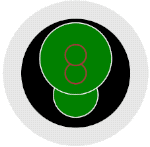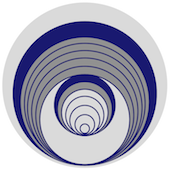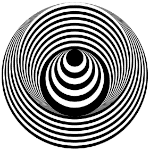 What can you see? The painter and conceptual artist Marcel Duchamp (1887-1968) developed the film Anemic Cinema together with Man Ray between 1920 and 1926. His contribution were (mostly spiral) drawings, which he called rotoreliefs. He let them rotate on a record player, creating pulsating three-dimensional effects. His attempt to sell the discs as optical toys was not very successful. But his discs are artistic examples of the stereokinetic effect.
What can you see? The painter and conceptual artist Marcel Duchamp (1887-1968) developed the film Anemic Cinema together with Man Ray between 1920 and 1926. His contribution were (mostly spiral) drawings, which he called rotoreliefs. He let them rotate on a record player, creating pulsating three-dimensional effects. His attempt to sell the discs as optical toys was not very successful. But his discs are artistic examples of the stereokinetic effect.
What can you do? There are four arrangements to choose from (1 ≤ no of effect ≤ 4). You can switch back and forth between these arrangements using the up/down buttons.




The speed of rotation is adjusted with the delta_angle slider (-180 ≤ delta_angle ≤ 180). A fine adjustment of the rotation in steps of 0.25 can be made with the right/left buttons. Finally, the background colour can also be changed with the bg_color slider (0 ≤ bg_color ≤ 99). With which arrangement is the effect most noticeable? What can be seen with very fast rotation (e.g. delta_angle > 25)?
 What else can you do? You can create your own arrangements just by adding new sets of parameters. In the palette Variables and at the beginning of the programme code you will find the variable list_disc_parameters. It contains the sets in the form of lists: the list shift indicates the position relative to the previous disc, the list radius the size of the disc and the list color its color.
What else can you do? You can create your own arrangements just by adding new sets of parameters. In the palette Variables and at the beginning of the programme code you will find the variable list_disc_parameters. It contains the sets in the form of lists: the list shift indicates the position relative to the previous disc, the list radius the size of the disc and the list color its color.
The example shows the simple sequence of smaller and smaller discs in a staggered arrangement. Please note that the same number of values must be entered in each case! So it’s that easy if you want to recreate other rotoreliefs by Duchamp.
Related topics: Stereokinetic Effect, Mach discs, flicker colors
References:
Marcel Duchamp Blog (2010). rotoreliefs.

